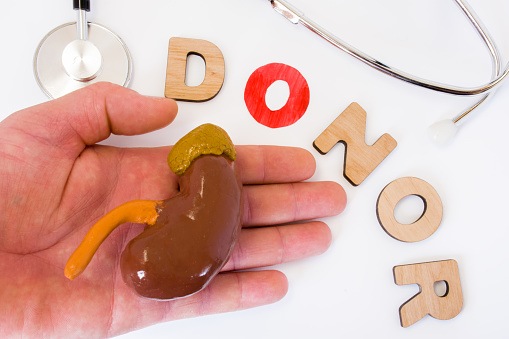
Patients who undergo successful kidney transplantation often experience weight gain; however, there are few data available on the specific changes in body composition that underlie the weight gain in low–immunity-risk patients. Further, the metabolic mechanisms that cause changes in body composition are not clearly identified.
Weight gain after kidney transplantation may be associated with the development of cardiovascular diseases and increased risk of mortality, and the amount of weight gained is an independent predictor of the development of insulin resistance and the risk of developing cardiovascular diseases. Biruh Workeneh, MD, and colleagues conducted a study to evaluate the weight gain and its composition and location in patients who underwent living donor kidney transplantation. The single-site, prospective, observational study examined metabolic determinants that could contribute to weight gain in that patient population. Results of the study were reported in the Journal of Renal Nutrition [2019;29(6):548-555].
A total of 187 living donor transplant candidates were screened for study participation between September 2014 and October 2016. Of those, 113 met inclusion criteria. Thirty-eight consented to participation and 33 were enrolled; five could not commit to the scheduled visits due to time constraints or transportation. Of the 33 enrolled, two withdrew following completion of the baseline studies due to transportation issues, resulting in a final study cohort of 31 subjects.
Among the 31 participants, mean age was 47.9 years, 87% (n=27) were men, mean weight at baseline was 83.3 kg, mean body mass index was 28.0 kg/m2, mean ideal body weight was 73.8 kg, 18 were white, five were black, one was Asian, and seven were Hispanic. The etiology of kidney failure was hypertension in seven participants, diabetes in five, glomerulopathy in nine, failed transplant in three, polycystic kidney disease in three, and unknown in four. Two of the patients received preemptive kidney transplantation and none required dialysis following transplantation. Three participants experienced acute rejection during the 12-month observation period; all three were successfully treated with a steroid taper.
At three months post-transplantation, there was a statistically significant increase in body weight (2.2 kg, P<.032); body weight increased further at 12 months post-transplantation (6.6 kg; P<.001). Measurements of body composition further contributed to the distribution of weight increase; the increase was largely due to an expansion of adiposity. In a four-component model that divides the body into fat, water, protein, and mineral used to measure body composition, the fat component was the only component found to have increased. At 12 months post-transplantation, the fat component increased by 5.4 kg; P=.002.
Dual-energy x-ray absorptiometry (DXA) analysis provided further insight into the distribution of fat. At both post-transplantation time points, there were increases in body fat (2.1 kg at 3 months and 5.1 kg at 12 months; P=.002 and P<.001, respectively). The DXA analysis showed that 71% of fat accumulation was in the truncal region. Additionally, the mean android-to-gynoid fat mass ratio significantly increased after kidney transplantation, indicating a redistribution or dysregulation of fat deposition. There were also significant increases in visceral and subcutaneous fat volumes at both time points.
Despite significant increases in fat mass, there were no significant changes in lean or skeletal muscle masses from baseline to either time point. The analyses of the 4-component model revealed that in contrast to changes in adipose tissue, there were no significant changes in the sizes of the remaining components.
The study also examined clinical factors that could contribute to the increase in adipose tissue. Differences in dietary factors were assessed prior to and after transplantation. With the exception of dietary fat, there were no significant differences in macronutrient and kilocalorie intake between visits. In measurements of resting energy expenditure, there were no significant changes in the resting metabolic rate between baseline and 3 months or 12 months. However, when standardized for body weight, there was a statistically significant decrease in basal metabolic rate per kg, indicating adipose tissue gain.
In analyses of the effects of physical activity on weight gain, transplant recipients were significantly more ambulatory post-transplant. The number of minutes of moderate and vigorous physical activity increased post-transplant; the difference between baseline and values at 12 months reached statistical significance.
Following exclusion of participants receiving insulin for diabetes control, results of analyses of changes in insulin sensitivity indicated worsening of insulin resistance. In measurements of the presence of total, subcutaneous, truncal, and visceral adipose stores at baseline and at 3 and 12 months, each of the adipose stores was associated with insulin resistance to varying degrees. Visceral adipose tissue had the strongest correlation with insulin resistance when correlated with the homeostatic model assessment of insulin resistance (r=0.67; P<.001).
The researchers did cite some limitations to the study, including the significant commitment required of the participants and the high proportion of men in the study population.
In conclusion, the researchers said, “Successful transplantation was associated with increased insulin resistance and weight gain without increases in muscle or fluid. This metabolic pattern suggests potential interventions that could prevent or mitigate the consequences of adipose tissue accumulation in transplant recipients.”
Takeaway Points
- Kidney transplant recipients commonly experience weight gain in the 12 months post-transplant. Researchers conducted a prospective observational study to examine the factors associated with weight gain after kidney transplant.
- The study population included recipients of living donor kidney transplants; among the participants, there was significant weight gain at 3 and 12 months post-transplant.
- The weight gain was due primarily to accumulation of adipose tissue in the truncal region; there were no increases in muscle mass or fluid accumulation.







 © 2025 Mashup Media, LLC, a Formedics Property. All Rights Reserved.
© 2025 Mashup Media, LLC, a Formedics Property. All Rights Reserved.